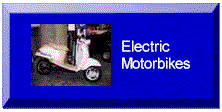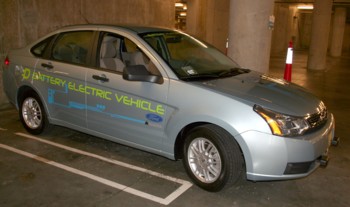







Ford Focus EV Test Drive
![]() About
About
![]() EVents Calendar
EVents Calendar ![]() FAQ
FAQ ![]() EV Selector
EV Selector ![]() Links
Links ![]() The EV Finder Archive
The EV Finder Archive ![]() Site
Map
Site
Map ![]() Blog
Blog
 The
2009 Los Angeles Auto Show gave me the opportunity to test drive Ford's all
electric Focus EV. I gladly signed up for a test drive at 10am on Thursday
morning. I got to where they were conducting the test drives about fifteen minutes early but the person
scheduled to drive the car at that time hadnít shown up so Steve Daleiden, who
is Fordís Battery Electric Vehicle power train systems engineer, showed me
what the car looked like under the hood and in the trunk.
The
2009 Los Angeles Auto Show gave me the opportunity to test drive Ford's all
electric Focus EV. I gladly signed up for a test drive at 10am on Thursday
morning. I got to where they were conducting the test drives about fifteen minutes early but the person
scheduled to drive the car at that time hadnít shown up so Steve Daleiden, who
is Fordís Battery Electric Vehicle power train systems engineer, showed me
what the car looked like under the hood and in the trunk.
The car that they were using for test drives is really a test mule based on the current Ford Focus body, not the new body style, that will be used in the production version of the car. Under the hood the engine has been replaced by a large metal box that contains the controller. The box clearly had Magna printed on the outside to show that Magna are the vendor that is supplying Ford with the electric power train. Most of the trunk space and the area normally occupied by the fuel tank are taken up by the battery pack. Charging is done via a receptacle sitting where you would normally find the fuel filler cap.
The inside of the Ford Focus EV was just like the standard Focus. There was no flashy instrumentation, just a speedometer, a gage that showed energy flow, a battery state of charge indicator, and a temperature gage that was left over from the standard focus but didnít do anything. The car was started by inserting a key into the ignition and turning it clockwise all the way. There was the faintest of clicks followed by a slight humming sound, which Steve explained was the vacuum pump, and the car was ready to go.
I pressed lightly on the accelerator and the car moved silently forward. I had to drive slowly at first to make sure I didnít plow down any of the people who were coming and going from test driving other vehicles. I noticed a very slight cogging at really low speed but this was much less noticeable than I have seen when driving a RAV4 EV. I mentioned this to Steve and he told me that they will be working to damp that out on the production vehicle.
Once out of the parking lot the car accelerated smoothly up to speed. Handling was pretty much what you would expect on a Ford Focus. The power assisted steering felt firm and precise, in fact very similar to the feel on my Prius. The ride was also pretty good giving a nice comfortable ride over the bumpy streets of down town LA.
Once I got out onto
He told me that the car I was driving gets a range of about 80 miles on a charge but they would push that up to 100 miles for the production version. Top speed is expected to be 95mph although at that speed range would be greatly diminished. Steve told me that some Ford Executives had been doing sprints up to 75mph in the car the previous week and had managed to deplete the battery pack in only 30 miles which just illustrates that how you dive the car is very important if you want to get good range.
All too soon I was back at the Convention Center. The car still needs some refinement and the instrument cluster will need to be upgraded to better meet the needs of and electric car, but the basic power train appears to be sound and they seem to have the suspension set up correctly. In my opinion, if Ford can get this car to market at a competitive price then they will have a winner. Steve told me that it was going to be his biggest challenge.